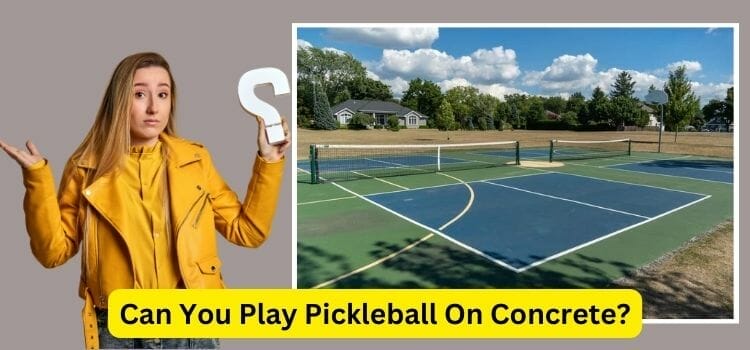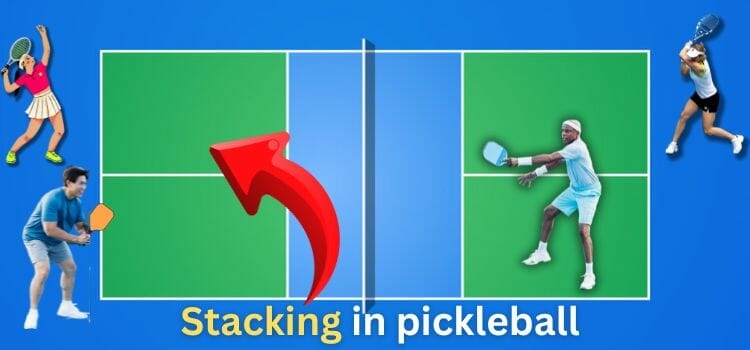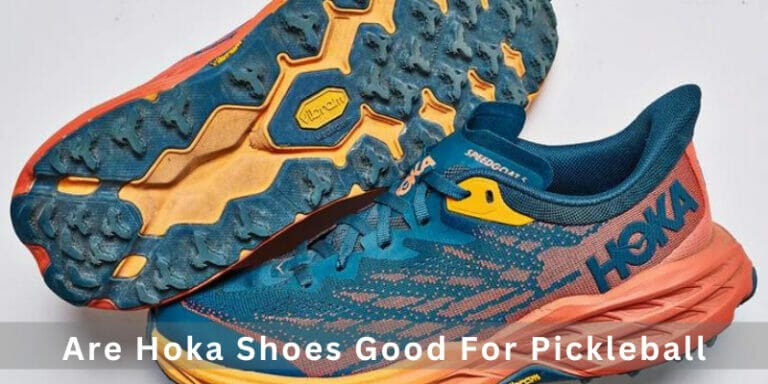What Is the Best Composite for a Pickleball Paddle | Best Guide

Looking for a pickleball paddle that delivers both power and control? The type of composite material you choose can make all the difference.
It is typically a combination of fiberglass and carbon fiber. These materials balance strength, stiffness, and lightweight properties, making for a durable and responsive paddle. The specific ratio of these materials may vary depending on personal preference and playing style.
In this article, we’ll delve into the world of pickleball paddles and explore the best composite materials for your playing style. If you’re wondering “What is the best composite for a pickleball paddle?”
Let’s Go down
Why Does the Composite Material Matter in a Pickleball Paddle?
The type of composite material used in a pickleball paddle can affect its performance. The paddle’s weight can impact how much power you can put behind your shots or how easy it is to move it around.
The durability of the paddle is also important so that it can handle the wear and tear of a pickleball player.
Lastly, a good paddle comes in balance, power, and control to help you play your best game.
Understanding the Role of the Composite Material
A comprises layers of different materials, which can affect how it plays. For instance, a paddle combining carbon and graphite faces might give you more power when you hit the ball.
On the other hand, if a paddle has more fiberglass in it, it offers better control. Manufacturers can create paddles that cater to different playing styles and abilities by using different materials in different amounts.
Types of Composite Materials Used in Pickleball Paddles
Three main types of pickleball paddles are used in composites: graphite, carbon fiber, and composites.
Graphite Pickleball Paddles: Pros and Cons
this is a popular material used in pickleball paddles. It’s lightweight and can provide a good balance of power and control.
However, it may not be as durable as other materials and can be more expensive.
Pros:
Lightweight
They are generally lighter than other materials, such as wood or composite, which can help players to generate more speed and power in their shots.
Durable
They are known for their durability and resistance to damage, which means they can last longer than others.
Increased power
They are also known for their increased power and ability to transfer energy from the paddle to the ball more efficiently, which can help players hit harder shots.
Better control
The smooth surface of graphite paddles provides better control over the ball, allowing players to place their shots more accurately.
Cons:
Expensive
They are more expensive than others, which may only be affordable for some players.
Stiffer feel
Some players may find that graphite paddles have a stiffer feel than other materials, impacting their comfort and control over the ball.
Less touch
They may have less touch and feel than other materials, making executing finesse shots such as dinks and drop shots easier.
Vibrations
It can sometimes produce more vibrations upon impact with the ball, affecting player comfort and control.
Carbon Fiber Pickleball Paddles: Pros and Cons
it is a strong and lightweight material that can provide much power. However, it may offer less control than other materials and can be expensive.
Pros:
Lightweight
These paddle weight are much lighter than traditional wood paddles. This makes them easier to maneuver and control during the game.
Durability
They are a strong, sturdy material that can withstand rough use and is less prone to scratches and dings. As a result, fiber new paddles tend last longer than others, reducing the need for replacements.
Performance
They offer superior performance and power. They provide a larger sweet spot, allowing for better accuracy and consistency in hitting the ball.
Comfort
These are designed with a comfortable grip that reduces hand fatigue during prolonged play.
Vibrations
They absorb vibrations, making them ideal for players with sensitive wrists or elbows.
Cons:
Cost
These paddles are more expensive than other materials, making them less accessible to some players.
Stiffness
They are stiffer than wood. While this offers increased power, it can be less forgiving for beginners or players with arm injuries.
Sound
They sound different from wood or composite pickle paddles available. Some players may find this distracting or uncomfortable.
Touch
Due to their stiffer nature, carbon fiber paddles can sometimes lack the touch and feel of wood which may impact control over delicate shots.
Composite Pickleball Paddles: Pros and Cons
They combine different materials, giving you a nice balance of power and control. Plus, they are more affordable than paddles made with only one material.
But here’s the thing: the durability of composite types of paddles can be hit or miss depending on the specific materials used.
Pros:
Lightweight
Composite pickleball paddles are typically lighter than others, making them easier to maneuver and swing.
Durable
They are made of materials such as fiberglass, carbon fiber, or graphite, which are known for their durability. This means they are less likely to break or crack than wooden ones.
Wide Range of Prices
They come in a wide range of prices, from relatively inexpensive entry-level models to high-end, professional-grade paddles.
Large Sweet Spot
They tend to have a larger sweet spot than wooden paddles, which means they can be more forgiving on off-center hits.
Cons:
Expensive
While entry-level paddles are reasonably priced, many higher-end models can be expensive.
Less Control
Some players feel they provide less control than wooden ones, especially for touch shots such as dinks and drops.
More Vibrations
They can generate more vibrations upon impact with the ball than, which can be uncomfortable for some players.
Non-Traditional Feel
Some players prefer the traditional feel of a wooden paddle and may prefer a different feel and sound.
Best Composite Materials for Pickleball Paddles
Different composite materials are used in pickleball paddles, each with advantages and disadvantages.
Fiberglass Pickleball Paddles: Pros and Cons
Fiberglass is a popular paddle face material because it’s a lightweight paddle and offers good control.
However, it may provide less power than other materials and can be less durable.
Fiberglass-Vinyl Pickleball Paddles: Pros and Cons
Fiberglass-vinyl is a newer material used in pickleball paddles. It’s lightweight, offers good control, and is more durable than fiberglass. However, it may provide less power than other materials.
Proprietary Composite Pickleball Paddles: Pros and Cons
Some manufacturers use their proprietary composite materials in their paddles. These can offer a unique combination of power and control and may be more durable.
However, they can also be more expensive than other materials.
What Is the Best Composite for a Pickleball Paddle Factors to Consider
When choosing material for your find the best composite pickleball paddles buying, there are several factors to consider:
Weight:
Weight is an important factor to consider. A heavier paddle will provide more power in your shots, while a lighter paddle will give you more control over your shots.
Remember that a lighter paddle may require more effort to generate power in your shots, while a heavy paddle may be more tiring to use over long periods.
Durability:
Durability is another important factor when choosing it. The composite material should withstand regular use and impact from the ball without cracking or breaking.
Additionally, some materials may be more resistant to weather conditions and moisture, which can extend the lifespan of your paddle.
Power and Control:
The composite material of your paddle can significantly affect the power and control of your shots.
These paddles are known for their power and are often preferred by players who want to hit harder shots.
Meanwhile, fiberglass paddles are known for their control, making them a good choice for players who want to finesse their shots.
Ultimately, it will depend on your personal playing style and preferences. Consider experimenting with different materials to find the one that suits you best.
Conclusion
At the end of the day, it will depend on your personal preferences and playing style. Graphite or carbon fiber may be the way to go if you want a lightweight pickleball paddle available with plenty of power.
A fiberglass or proprietary first paddle may be better if you’re more concerned about durability.
Ultimately, the key is to find a paddle that feels comfortable in your hand and allows you to play your best game. So try different graphite or composites and paddles.
Don’t design until you find the perfect fit. With the right paddle, you’ll be well on your way to dominating the pickleball court.
FAQs
What Surface Is Best For A Pickleball Paddle?
The surface of a pickleball paddle should be made of hard material with a textured or slightly rough surface. Materials like graphite, fiberglass, or composite are good choices. The surface should also be durable and able to withstand repeated hits from the pickleball.
Is Carbon Or Graphite Better For A Pi56ckleball Paddle?
These are similar materials, but carbon may offer slightly better performance due to its stiffness and strength.
Is Graphite Or Fiberglass Better For A Pickleball Paddle?
They offer more power and control but are less forgiving on off-center hits. Fiberglass provides a better feel and is more forgiving but may offer less power. It ultimately depends on your playing style and preferences.
What Should Pickleball Paddles Be Made Of?
Pickleball paddles can be made of various materials, including composite blends, fiberglass, graphite, carbon fiber, or proprietary materials. It ultimately depends on the player’s preference and budget.






